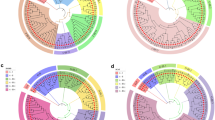Summary
Bamboo species are difficult to identify because flowering material is seldom available and taxonomy is of necessity based on vegetative characters. To evaluate the utility of restriction fragment length polymorphism (RFLP) analysis in bamboo systematics and germplasm screening, a library of random genomic probes from a Phyllostachys nigra PstI library was constructed. Probes from the library were used to screen bamboo germplasm consisting mostly of temperate bamboos of the genus Phyllostachys. RFLP variation was abundant, and species-specific patterns were readily obtained. Chloroplast DNA showed little variation among the bamboo accessions analyzed.
Similar content being viewed by others
Reference
Adamson WC, White GA, DeRigo HT, Hawley WO (1978) Bamboo production research at Savannah, Georgia, 1956–1977. Agric Res Serv Publ ARS-S-176
Dallas JF (1988) Detection of DNA “fingerprints” of cultivated rice by hybridization with a human minisatellite DNA probe. Proc Natl Acad Sci USA 85:6831–6835
Farrelly D (1984) The book of bamboo. Sierra Club Books, San Francisco, Calif.
Feinberg AP, Vogelstein B (1984) A technique for radiolabeling DNA restriction fragments to a high specific activity. Anal Biochem 132:6–13
Hiratsuka J, Shimada H, Whittier R, Ishibashi T, Sakamoto M, Mori M, Kondo C, Honji Y, Sun C-R, Meng B-Y, Li Y-Q, Kanno A, Nishizawa Y, Hirai A, Shinozaki K, Sugiura M (1989) The complete sequence of the rice (Oryza sativa) chloroplast genome: Intermolecular recombination between distinct tRNA genes accounts for a major plastid DNA inversion during the evolution of the cereals. Mol Gen Genet 217:185–194
Jantzen DH (1976) Why bamboos wait so long to flower. Annu Rev Ecol Syst 7:347–391
Jeffreys AJ, Wilson V, Thein SL (1985) Individual-specific “fingerprints” of human DNA. Nature 316:76–79
McClure RA (1956) Bamboo in the economy of oriental peoples. Econ Bot 10:335–361
McClure RA (1966) The bamboos: a fresh perspective. Harvard University Press, Cambridge, Mass.
McCouch SR, Kochert G, Yu ZH, Wang ZY, Khush GS, Coffman WR, Tanksley SD (1988) Molecular mapping of rice chromosomes. Theor Appl Gen 76:148–149
Nadgauda RS, Parasharami VA, Mascarenhas AF (1990) Precocious flowering and seeding behaviour in tissue-cultured bamboos. Nature 344:335–336
Nakamura Y, Leppert M, O'Connell P (1987) Variable number of tandem repeat (VNTR) markers for human gene mapping. Science 235:1616–1622
Nybom H, Rogstad SH, Schaal BA (1990) Genetic variation detected by use of the M13 DNA fingerprint probe in Malus, Prunus, and Rubus (Rosaceae). Theor Appl Genet 79:153–156
Ohyama K, Fukuzawa H, Kohchi T, Shirai H, Sano T, Sano S, Umesono K, Shiki Y, Takeuchi M, Chang Z, Aota SI, Inokuchi H, Ozeki H (1986) Chloroplast gene organization deduced from complete sequence of liverwort Marchantia polymorpha chloroplast DNA. Nature 322:572–574
Palmer JD (1985) Comparative organization of chloroplast genomes. Annu Rev Genet 19:325–354
Palmer JD (1990) Contrasting modes and tempos of genome evolution in land plant organelles. Trends Genet 6:115–120
Palmer JD, Stein DB (1986) Conservation of chloroplast genome structure among vascular plants. Curr Genet 10:823–833
Rigby P, Dieckmann M, Rhodes C, Berg P (1977) Labeling deoxyribonucleic acid to high specific activity in vitro by nick-translation with DNA polymerase I. J Mol Biol 113:237–251
Rogstad SH, Patton JC, Schaal BA (1988) A human minisatellite probe reveals RFLPs among individuals of two angiosperms. Nucleic Acids Res 16:11378
Sambrook J, Fritsch EF, Maniatis T (1989) Molecular cloning. A laboratory manual, 2nd edn Cold Spring Harbor Laboratory Press, Cold Spring Harbor, N.Y.
Shinozaki K, Ohme M, Tanaka M, Wakasugi T, Hayashida N, Matsubayashi T, Zaita N, Chunwongse J, Obokata J Yamaguchi-Shinozaki K, Ohto C, Torazawa K, Meng BY, Sugita M, Deno H, Kamogashira T, Yamada K, Kusuda J, Takaiwa F, Kato A, Tohdoh N, Shimada H, Sugiura M (1986) The complete nucleotide sequence of the tobacco chloroplast genome: its gene organization and expression. EMBO J 5:2043–2049
Soderstrom TR (1979) The bamboozling Thamnocalamus. Gard Mag Jul/Aug 22–27
Soderstrom TR (1981) Some evolutionary trends in the bambusoideae. Ann Miss Bot Gard 68:15–47
Soderstrom TR, Ellis RP (1986) The position of bamboo genera and allies in a system of grass classification. In: Soderstrom TR, Hilu KW, Campbell CS, Barkworth ME (eds) Grass systematics and evolution. Smithsonian Institute Press, Washington, D.C., pp 225–238
Song KM, Osborn TC, Williams PH (1988a) Brassica taxonomy based on nuclear restriction fragment length polymorphisms (RFLPs). Theor Appl Genet 75:784–794
Song KM, Osborn TC, Williams PH (1988b) Brassica taxonomy based on nuclear restriction fragment length polymorphisms (RFLPs). 2. Preliminary analysis of subspecies within B. rapa (syn. campestris) and B. oleracea. Theor Appl Genet 76:593–600
Song K, Osborn TC, Williams PH (1990) Brassica taxonomy based on nuclear restriction fragment length polymorphisms (RFLPs). 3. Genome relationships in Brassica and related genera and the origin of B. oleracea and B. rapa (Syn campestris). Theor Appl Genet 79:497–506
Southern EM (1975) Detection of specific sequences among DNA fragments separated by gel electrophoresis. J Mol Biol 98:503–517
Wilimzig R (1985) LiCl boiling method for plasmid minipreps. Trends Genet 1:158
Author information
Authors and Affiliations
Additional information
Communicated by P. L. Pfahler
Rights and permissions
About this article
Cite this article
Friar, E., Kochert, G. Bamboo germplasm screening with nuclear restriction fragment length polymorphisms. Theoret. Appl. Genetics 82, 697–703 (1991). https://doi.org/10.1007/BF00227313
Received:
Accepted:
Issue Date:
DOI: https://doi.org/10.1007/BF00227313



